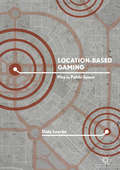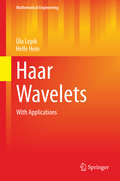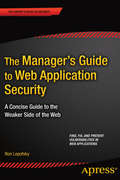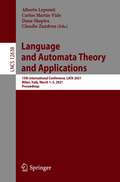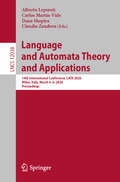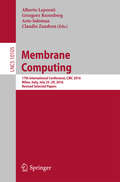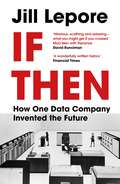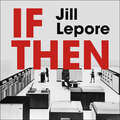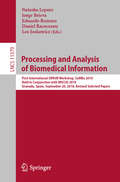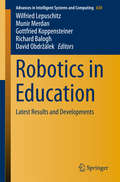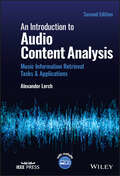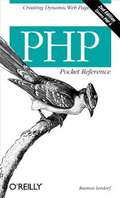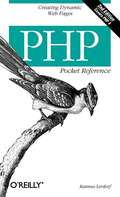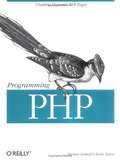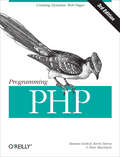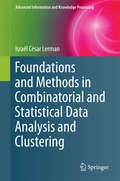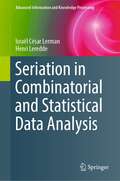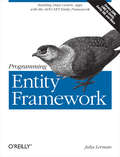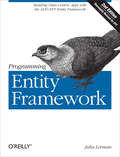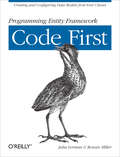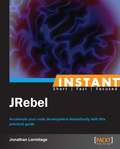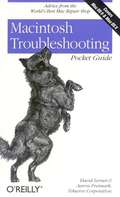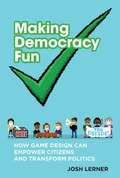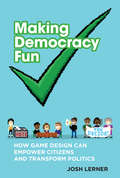- Table View
- List View
Location-Based Gaming: Play in Public Space
by Dale LeorkeLocation-based games emerged in the early 2000s following the commercialisation of GPS and artistic experimentation with ‘locative media’ technologies. Location-based games are played in everyday public spaces using GPS and networked, mobile technologies to track their players’ location. This book traces the evolution of location-based gaming, from its emergence as a marginal practice to its recent popularisation through smartphone apps like Pokémon Go and its incorporation into ‘smart city’ strategies. Drawing on this history and an analysis of the scholarly and mainstream literature on location-based games, Leorke unpacks the key claims made about them. These claims position location-based games as alternately enriching or diminishing their players’ engagement with the people and places they encounter through the game. Through rich case studies and interviews with location-based game designers and players, Leorke tests out and challenges these celebratory and pessimistic discourses. He argues for a more grounded approach to researching location-based games and their impact on public space that reflects the ideologies, lived experiences, and institutional imperatives that circulate around their design and performance. By situating location-based games within broader debates about the role of play and digitisation in public life, Location-Based Gaming offers an original and timely account of location-based gaming and its growing prominence.
Haar Wavelets
by Ülo Lepik Helle HeinThis is the first book to present a systematic review of applications of the Haar wavelet method for solving Calculus and Structural Mechanics problems. Haar wavelet-based solutions for a wide range of problems, such as various differential and integral equations, fractional equations, optimal control theory, buckling, bending and vibrations of elastic beams are considered. Numerical examples demonstrating the efficiency and accuracy of the Haar method are provided for all solutions.
The Manager's Guide to Web Application Security:
by Ron LepofskyThe Manager's Guide to Web Application Security is a concise, information-packed guide to application security risks every organization faces, written in plain language, with guidance on how to deal with those issues quickly and effectively. Often, security vulnerabilities are difficult to understand and quantify because they are the result of intricate programming deficiencies and highly technical issues. Author and noted industry expert Ron Lepofsky breaks down the technical barrier and identifies many real-world examples of security vulnerabilities commonly found by IT security auditors, translates them into business risks with identifiable consequences, and provides practical guidance about mitigating them. The Manager's Guide to Web Application Security describes how to fix and prevent these vulnerabilities in easy-to-understand discussions of vulnerability classes and their remediation. For easy reference, the information is also presented schematically in Excel spreadsheets available to readers for free download from the publisher's digital annex. The book is current, concise, and to the point--which is to help managers cut through the technical jargon and make the business decisions required to find, fix, and prevent serious vulnerabilities.
Language and Automata Theory and Applications: 15th International Conference, LATA 2021, Milan, Italy, March 1–5, 2021, Proceedings (Lecture Notes in Computer Science #12638)
by Alberto Leporati Carlos Martín-Vide Dana Shapira Claudio ZandronThis book constitutes the proceedings of the 15th International Conference on Language and Automata Theory and Applications, LATA 2021, held in Milan, Italy, in March 2021. The 26 full papers presented in this volume were carefully reviewed and selected from 52 submissions. They were organized in topical sections named: algebraic structures; automata; complexity; learning; logics and languages; trees and graphs; and words and strings.
Language and Automata Theory and Applications: 14th International Conference, LATA 2020, Milan, Italy, March 4–6, 2020, Proceedings (Lecture Notes in Computer Science #12038)
by Alberto Leporati Carlos Martín-Vide Dana Shapira Claudio ZandronThis book constitutes the proceedings of the 14th International Conference on Language and Automata Theory and Applications, LATA 2020, which was planned to be held in Milan, Italy, in March 2020. Due to the corona pandemic, the actual conference was postponed and will be held together with LATA 2021.The 26 full papers presented in this volume were carefully reviewed and selected from 59 submissions. They were organized in topical sections named: algebraic structures; automata; complexity; grammars; languages; trees and graphs; and words and codes. The book also contains 6 invited papers in full-paper length.
Membrane Computing
by Alberto Leporati Grzegorz Rozenberg Arto Salomaa Claudio ZandronPart of the broader research field of natural computing, Membrane Computing is an area within computing science that aims to abstract computing ideas and models from the structure and functioning of living cells, as well as from the way the cells are organized in tissues or higher order structures. This handbook provides both a comprehensive survey of available knowledge and established research topics, and a guide to recent developments in the field, covering thesubject from theory to applications. The handbook is suitable both for introducing novices to this area of research, and as a main source of reference for active researchers. It sets out the necessary biological and formal background, with the introductory chapter serving as a gentle introduction toand overview of membrane computing. Individual chapters, written by leading researchers in membrane computing, present the state of the art of all main r`search trends and include extensive bibliographies.
If Then: How One Data Company Invented the Future
by Jill LeporeRadio 4's Book of the WeekA Financial Times Book of the YearShortlisted for the 2020 Financial Times / McKinsey Business Book of the YearLonglisted for the National Book Award 'The story of the original data science hucksters of the 1960s is hilarious, scathing and sobering - what you might get if you crossed Mad Men with Theranos' David RuncimanThe Simulmatics Corporation, founded in 1959, mined data, targeted voters, accelerated news, manipulated consumers, destabilized politics, and disordered knowledge--decades before Facebook, Google, Amazon, and Cambridge Analytica. Silicon Valley likes to imagine it has no past but the scientists of Simulmatics are the long-dead grandfathers of Mark Zuckerberg and Elon Musk. Borrowing from psychological warfare, they used computers to predict and direct human behavior, deploying their "People Machine" from New York, Cambridge, and Saigon for clients that included John Kennedy's presidential campaign, the New York Times, Young & Rubicam, and, during the Vietnam War, the Department of Defence. In If Then, distinguished Harvard historian and New Yorker staff writer, Jill Lepore, unearths from the archives the almost unbelievable story of this long-vanished corporation, and of the women hidden behind it. In the 1950s and 1960s, Lepore argues, Simulmatics invented the future by building the machine in which the world now finds itself trapped and tormented, algorithm by algorithm.'A person can't help but feel inspired by the riveting intelligence and joyful curiosity of Jill Lepore. Knowing that there is a mind like hers in the world is a hope-inducing thing' George Saunders, Man Booker Prize-winning author of Lincoln in the Bardo'An authoritative account of the origins of data science, a compelling political narrative of America in the Sixties, a poignant collective biography of a generation of flawed men' David Kynaston'If Then is simultaneously gripping and absolutely terrifying' Amanda Foreman
If Then: How One Data Company Invented the Future
by Jill LeporeRadio 4's Book of the WeekA Financial Times Book of the YearShortlisted for the 2020 Financial Times / McKinsey Business Book of the YearLonglisted for the National Book Award 'The story of the original data science hucksters of the 1960s is hilarious, scathing and sobering - what you might get if you crossed Mad Men with Theranos' David RuncimanThe Simulmatics Corporation, founded in 1959, mined data, targeted voters, accelerated news, manipulated consumers, destabilized politics, and disordered knowledge--decades before Facebook, Google, Amazon, and Cambridge Analytica. Silicon Valley likes to imagine it has no past but the scientists of Simulmatics are the long-dead grandfathers of Mark Zuckerberg and Elon Musk. Borrowing from psychological warfare, they used computers to predict and direct human behavior, deploying their "People Machine" from New York, Cambridge, and Saigon for clients that included John Kennedy's presidential campaign, the New York Times, Young & Rubicam, and, during the Vietnam War, the Department of Defence. In If Then, distinguished Harvard historian and New Yorker staff writer, Jill Lepore, unearths from the archives the almost unbelievable story of this long-vanished corporation, and of the women hidden behind it. In the 1950s and 1960s, Lepore argues, Simulmatics invented the future by building the machine in which the world now finds itself trapped and tormented, algorithm by algorithm.'A person can't help but feel inspired by the riveting intelligence and joyful curiosity of Jill Lepore. Knowing that there is a mind like hers in the world is a hope-inducing thing' George Saunders, Man Booker Prize-winning author of Lincoln in the Bardo'An authoritative account of the origins of data science, a compelling political narrative of America in the Sixties, a poignant collective biography of a generation of flawed men' David Kynaston'If Then is simultaneously gripping and absolutely terrifying' Amanda Foreman
Processing and Analysis of Biomedical Information: First International SIPAIM Workshop, SaMBa 2018, Held in Conjunction with MICCAI 2018, Granada, Spain, September 20, 2018, Revised Selected Papers (Lecture Notes in Computer Science #11379)
by Natasha Lepore Jorge Brieva Eduardo Romero Daniel Racoceanu Leo JoskowiczThis book constitutes the refereed proceedings of the First International SIPAIM Workshop on Processing and Analysis of Biomedical Information, SaMBa 2018, held in conjunction with MICCAI 2018, in Granada, Spain, in September 2018. The 14 full papers presented were carefully reviewed and selected for inclusion in this volume. The papers cover the following topics: Medical imaging, Digital pathology, E-health, and Motor analysis and biosignals. The purpose was to present success stories of science, research and innovation stemming from Latin American and to encourage the formation of international academic networks in biomed- ical research with a strong component in medical information processing.
Robotics in Education
by Wilfried Lepuschitz Munir Merdan Gottfried Koppensteiner Richard Balogh David ObdržálekThis proceedings volume showcases the latest achievements in research and development in Educational Robotics presented at the 7th International Conference on Robotics in Education (RiE) held in Vienna, Austria, during April 14-15, 2016. The book offers a range of methodologies for teaching robotics and presents various educational robotics curricula. It includes dedicated chapters for the design and analysis of learning environments as well as evaluation means for measuring the impact of robotics on the students' learning success. Moreover, the book presents interesting programming approaches as well as new applications, the latest tools, systems and components for using robotics. The presented applications cover the whole educative range, from elementary school to high school, college, university and beyond, for continuing education and possibly outreach and workforce development. The book provides a framework involving two complementary kinds of contributions: on the one hand on technical aspects and on the other hand on matters of didactic.
An Introduction to Audio Content Analysis: Music Information Retrieval Tasks and Applications
by Alexander LerchAn Introduction to Audio Content Analysis Enables readers to understand the algorithmic analysis of musical audio signals with AI-driven approaches An Introduction to Audio Content Analysis serves as a comprehensive guide on audio content analysis explaining how signal processing and machine learning approaches can be utilized for the extraction of musical content from audio. It gives readers the algorithmic understanding to teach a computer to interpret music signals and thus allows for the design of tools for interacting with music. The work ties together topics from audio signal processing and machine learning, showing how to use audio content analysis to pick up musical characteristics automatically. A multitude of audio content analysis tasks related to the extraction of tonal, temporal, timbral, and intensity-related characteristics of the music signal are presented. Each task is introduced from both a musical and a technical perspective, detailing the algorithmic approach as well as providing practical guidance on implementation details and evaluation. To aid in reader comprehension, each task description begins with a short introduction to the most important musical and perceptual characteristics of the covered topic, followed by a detailed algorithmic model and its evaluation, and concluded with questions and exercises. For the interested reader, updated supplemental materials are provided via an accompanying website. Written by a well-known expert in the music industry, sample topics covered in Introduction to Audio Content Analysis include: Digital audio signals and their representation, common time-frequency transforms, audio features Pitch and fundamental frequency detection, key and chord Representation of dynamics in music and intensity-related features Beat histograms, onset and tempo detection, beat histograms, and detection of structure in music, and sequence alignment Audio fingerprinting, musical genre, mood, and instrument classification An invaluable guide for newcomers to audio signal processing and industry experts alike, An Introduction to Audio Content Analysis covers a wide range of introductory topics pertaining to music information retrieval and machine listening, allowing students and researchers to quickly gain core holistic knowledge in audio analysis and dig deeper into specific aspects of the field with the help of a large amount of references.
PHP Pocket Reference
by Rasmus LerdorfSimple, to the point, and compact--in fact, exactly what you've come to expect in an O'Reilly Pocket Reference--the second edition of PHP Pocket Reference is thoroughly updated to include the specifics of PHP 4. Written by the founder of the PHP Project, Rasmus Lerdorf, PHP Pocket Reference is both a handy introduction to PHP syntax and structure, and a quick reference to the vast array of functions provided by PHP. The quick reference section organizes all the core functions of PHP alphabetically so you can find what you need easily; the slim size means you can keep it handy beside your keyboard for those times when you want to look up a function quickly without closing what you're doing. This valuable little book provides an authoritative overview of PHP packed into a pocket-sized guide that's easy to take anywhere. It is also the ideal companion for O'Reilly's comprehensive book on PHP, Programming PHP. The PHP Pocket Reference an indispensable (and inexpensive) tool for any serious PHP coder.
PHP Pocket Reference, 2nd Edition
by Rasmus LerdorfSimple, to the point, and compact, the second edition of PHP Pocket Referenceis thoroughly updated to include the specifics of PHP 4, the language's latest version. It is both a handy introduction to PHP syntax and structure, and a quick reference to the vast array of functions provided by PHP. The quick reference section organizes all the core functions of PHP alphabetically so you can find what you need easily.
Programming PHP
by Rasmus Lerdorf Kevin TatroeProgramming PHPis a comprehensive guide to PHP, a simple yet powerful language for creating dynamic web content. Filled with the unique knowledge of the creator of PHP, Rasmus Lerdorf, this book is a detailed reference to the language and its applications, including such topics as form processing, sessions, databases, XML, and graphics. Covers PHP 4, the latest version of the language.
Programming PHP: Creating Dynamic Web Pages (Apresspod Ser.)
by Rasmus Lerdorf Kevin Tatroe Peter MacintyreProgramming PHP, 2nd Edition, is the authoritative guide to PHP 5 and is filled with the unique knowledge of the creator of PHP (Rasmus Lerdorf) and other PHP experts. When it comes to creating websites, the PHP scripting language is truly a red-hot property. In fact, PHP is currently used on more than 19 million websites, surpassing Microsoft's ASP .NET technology in popularity. Programmers love its flexibility and speed; designers love its accessibility and convenience. As the industry standard book on PHP, all of the essentials are covered in a clear and concise manner. Language syntax and programming techniques are coupled with numerous examples that illustrate both correct usage and common idioms. With style tips and practical programming advice, this book will help you become not just a PHP programmer, but a good PHP programmer. Programming PHP, Second Edition covers everything you need to know to create effective web applications with PHP. Contents include: Detailed information on the basics of the PHP language, including data types, variables, operators, and flow control statements Chapters outlining the basics of functions, strings, arrays, and objects Coverage of common PHP web application techniques, such as form processing and validation, session tracking, and cookies Material on interacting with relational databases, such as MySQL and Oracle, using the database-independent PEAR DB library and the new PDO Library Chapters that show you how to generate dynamic images, create PDF files, and parse XML files with PHP Advanced topics, such as creating secure scripts, error handling, performance tuning, and writing your own C language extensions to PHP A handy quick reference to all the core functions in PHP and all the standard extensions that ship with PHP Praise for the first edition: "If you are just getting into the dynamic Web development world or you are considering migrating from another dynamic web product to PHP, Programming PHP is the book of choice to get you up, running, and productive in a short time." --Peter MacIntrye, eWeek "I think this is a great book for programmers who want to start developing dynamic websites with PHP. It gives a detailed overview of PHP, lots of valuable tips, and a good sense of PHP's strengths." --David Dooling, Slashdot.org
Foundations and Methods in Combinatorial and Statistical Data Analysis and Clustering
by Israël César LermanThis bookoffers an original and broad exploration of the fundamental methods in Clusteringand Combinatorial Data Analysis, presenting new formulations and ideas withinthis very active field. With extensive introductions, formal andmathematical developments and real case studies, this book provides readerswith a deeper understanding of the mutual relationships between these methods,which are clearly expressed with respect to three facets: logical,combinatorial and statistical. Usingrelational mathematical representation, all types of data structures can behandled in precise and unified ways which the author highlights in three stages: Clustering a set of descriptive attributes Clustering a set of objects or a set of objectcategories Establishing correspondence between these twodual clusterings Tools forinterpreting the reasons of a given cluster or clustering are also included. Foundations and Methods in Combinatorial andStatistical Data Analysis and Clustering will be a valuable resource for students andresearchers who are interested in the areas of Data Analysis, Clustering, DataMining and Knowledge Discovery.
Seriation in Combinatorial and Statistical Data Analysis (Advanced Information and Knowledge Processing)
by Israël César Lerman Henri LereddeThis monograph offers an original broad and very diverse exploration of the seriation domain in data analysis, together with building a specific relation to clustering.Relative to a data table crossing a set of objects and a set of descriptive attributes, the search for orders which correspond respectively to these two sets is formalized mathematically and statistically. State-of-the-art methods are created and compared with classical methods and a thorough understanding of the mutual relationships between these methods is clearly expressed. The authors distinguish two families of methods:Geometric representation methodsAlgorithmic and Combinatorial methods Original and accurate methods are provided in the framework for both families. Their basis and comparison is made on both theoretical and experimental levels. The experimental analysis is very varied and very comprehensive. Seriation in Combinatorial and Statistical Data Analysis has a unique character in the literature falling within the fields of Data Analysis, Data Mining and Knowledge Discovery. It will be a valuable resource for students and researchers in the latter fields.
Programming Entity Framework: Code First
by Julia LermanIf you use Entity Framework in Visual Studio 2008 and .NET 3.5, this is the book you want. Programming Entity Framework, 1st Edition offers experienced developers a thorough introduction to Microsoft's core framework for modeling and interacting with data in .NET applications. This hands-on tour provides a deep understanding of Entity Framework's architecture and APIs, and explains how to use the framework in a variety of applications built with Visual Studio 2008 and .NET 3.5.From the Entity Data Model (EDM) and Object Services to EntityClient and the Metadata Workspace, this highly acclaimed first edition covers it all.Understand the core concepts you need to make the best use of the Entity Framework (EF) in your applicationsLearn to query your data, using either LINQ to Entities or Entity SQLCreate Windows Forms, WPF, and ASP.NET applicationsBuild ASMX web services and WCF servicesUse Object Services to work directly with your entity objectsDelve into model customization, relationship management, change tracking, data concurrency, and moreOne important note: while many of the lessons from this book will continue to be valuable as you move to .NET 4, the thoroughly revised second edition of Programming Entity Framework (August 2010) specifically targets Visual Studio 2010 and .NET 4 -- where there have been many advancements and additions to the framework.
Programming Entity Framework: Building Data Centric Apps with the ADO.NET Entity Framework (Oreilly And Associate Ser.)
by Julia LermanGet a thorough introduction to ADO.NET Entity Framework 4 -- Microsoft's core framework for modeling and interacting with data in .NET applications. The second edition of this acclaimed guide provides a hands-on tour of the framework latest version in Visual Studio 2010 and .NET Framework 4. Not only will you learn how to use EF4 in a variety of applications, you'll also gain a deep understanding of its architecture and APIs. Written by Julia Lerman, the leading independent authority on the framework, Programming Entity Framework covers it all -- from the Entity Data Model and Object Services to WCF Services, MVC Apps, and unit testing. This book highlights important changes for experienced developers familiar with the earlier version. Understand the core concepts you need to make the best use of the EF4 in your applications Learn to query your data, using either LINQ to Entities or Entity SQL Create Windows Forms, WPF, ASP.NET Web Forms, and ASP.NET MVC applications Build and consume WCF Services, WCF Data Services, and WCF RIA Services Use Object Services to work directly with your entity objects Create persistent ignorant entities, repositories, and write unit tests Delve into model customization, relationship management, change tracking, data concurrency, and more Get scores of reusable examples -- written in C# (with notes on Visual Basic syntax) -- that you can implement right away
Programming Entity Framework: Creating and Configuring Data Models from Your Classes
by Julia Lerman Rowan Miller<p>Take advantage of the Code First data modeling approach in ADO.NET Entity Framework, and learn how to build and configure a model based on existing classes in your business domain. With this concise book, you’ll work hands-on with examples to learn how Code First can create an in-memory model and database by default, and how you can exert more control over the model through further configuration.</p>
Instant JRebel
by Jonathan LermitageFilled with practical, step-by-step instructions and clear explanations for the most important and useful tasks. This book is an easy-to-follow guide full of hands-on examples of real-world Java development tasks. Each topic is explained and placed in context, and for the more inquisitive readers, there are more-in-depth details of the concepts used.If you have experience in Java desktop or web application development based on Servlets and you want to update your code instantly without recompiling and redeploying the code, this book is for you.
Macintosh Troubleshooting Pocket Guide
by David LernerThe Macintosh Troubleshooting Pocket Guide covers the most common user hardware and software trouble. It's not just a book for Mac OS X (although it includes tips for OS X and Jaguar), it's for anyone who owns a Mac of any type-- there are software tips going back as far as OS 6. This slim guide distills the answers to the urgent questions that Tekserve's employee's answer every week into a handy guide that fits in your back pocket or alongside your keyboard.
Macintosh Troubleshooting Pocket Guide
by David Lerner Aaron Freimark Tekserve CorporationTekserve Corporation, the distinctive (and somewhat eccentric but excellent) Macintosh repair store in New York City, has long provided its customers with a free "Frequently Asked Questions" document to cover the most common troubleshooting questions. We recently discovered this FAQ sheet and realized that-like New York itself-it was too good to leave just for the New Yorkers. With the help of Tekserve's owners, we turned this FAQ sheet into the Macintosh Troubleshooting Pocket Guide. This handy little book covers the most common user hardware and software troubles, from disks stuck in drives to lost files-there are software tips going back as far as OS 6! Tekserve updates their FAQ sheet based on the frequency of questions from real users who come into the store every week. This guide is easy to take and use anywhere.
Making Democracy Fun
by Josh LernerAnyone who has ever been to a public hearing or community meeting would agree that participatory democracy can be boring. Hours of repetitive presentations, alternatingly alarmist or complacent, for or against, accompanied by constant heckling, often with no clear outcome or decision. Is this the best democracy can offer? In Making Democracy Fun, Josh Lerner offers a novel solution for the sad state of our deliberative democracy: the power of good game design. What if public meetings featured competition and collaboration (such as team challenges), clear rules (presented and modeled in multiple ways), measurable progress (such as scores and levels), and engaging sounds and visuals? These game mechanics would make meetings more effective and more enjoyable -- even fun. Lerner reports that institutions as diverse as the United Nations, the U.S. Army, and grassroots community groups are already using games and game-like processes to encourage participation. Drawing on more than a decade of practical experience and extensive research, he explains how games have been integrated into a variety of public programs in North and South America. He offers rich stories of game techniques in action, in children's councils, social service programs, and participatory budgeting and planning. With these real-world examples in mind, Lerner describes five kinds of games and twenty-six game mechanics that are especially relevant for democracy. He finds that when governments and organizations use games and design their programs to be more like games, public participation becomes more attractive, effective, and transparent. Game design can make democracy fun -- and make it work.
Making Democracy Fun: How Game Design Can Empower Citizens and Transform Politics (The\mit Press Ser.)
by Josh A. LernerDrawing on the tools of game design to fix democracy. Anyone who has ever been to a public hearing or community meeting would agree that participatory democracy can be boring. Hours of repetitive presentations, alternatingly alarmist or complacent, for or against, accompanied by constant heckling, often with no clear outcome or decision. Is this the best democracy can offer? In Making Democracy Fun, Josh Lerner offers a novel solution for the sad state of our deliberative democracy: the power of good game design. What if public meetings featured competition and collaboration (such as team challenges), clear rules (presented and modeled in multiple ways), measurable progress (such as scores and levels), and engaging sounds and visuals? These game mechanics would make meetings more effective and more enjoyable—even fun.Lerner reports that institutions as diverse as the United Nations, the U.S. Army, and grassroots community groups are already using games and game-like processes to encourage participation. Drawing on more than a decade of practical experience and extensive research, he explains how games have been integrated into a variety of public programs in North and South America. He offers rich stories of game techniques in action, in children's councils, social service programs, and participatory budgeting and planning. With these real-world examples in mind, Lerner describes five kinds of games and twenty-six game mechanics that are especially relevant for democracy. He finds that when governments and organizations use games and design their programs to be more like games, public participation becomes more attractive, effective, and transparent. Game design can make democracy fun—and make it work.
